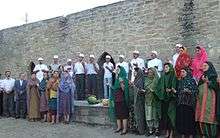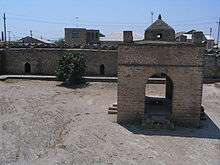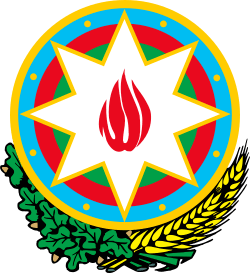Zoroastrianism in Azerbaijan
| Part of a series on |
| Azerbaijanis |
|---|
| Culture |
| Traditional areas of settlement |
| Diaspora |
| Religion |
| Language |
| Persecution |
|

Zoroastrianism in Azerbaijan goes back to the first millennium BC or earlier and was the predominant religion of Greater Iran before the conversion to Islam. The name Azerbaijan is Persian and means "protect(or) of Fire",[1] which is said to have a direct link with Zoroastrianism.[2]
Today the religion, culture and traditions of Zoroastrianism remains highly respected in Azerbaijan, and the new year Nowruz continues to be the main holiday in the country. Zoroastrianism has left a deep mark in the history of Azerbaijan. Traces of the religion are still visible in Surakhany,[3] Khinalyg, and Yanar Dag.
History
One of the world`s oldest religions Zoroastrianism was also practiced in the territory of Azerbaijan in ancient times. Zoroastrianism, sharing its name with its founder Iranian prophet Zoroaster (also known as Zarathustra), was the first monotheistic belief in the world and the official religion in Persia from 600 BCE to 650 CE.
Zoroastrians believed that a god called Ahura Mazda (Wise Lord) created the universe. Sacred book of Zoroastrianism Avesta consists of two main sections: the oldest section contains the Gathas including seventeen hymns and the younger Avesta containing commentaries to the older one. It also includes myths, stories and details of ritual observances. Fire is the most important symbol of the Zoroastrianism. Zoroastrians worshipped fire, because they believed that the fire represented the Holy Spirit of Ahura Mazda.
About the date of birth of Zoroaster, historians mostly agree upon the dates of 660-583 BC with birth place being the lands of Azerbaijan. According to the local legends, Zoroaster was born in Caucasian Albania. But this idea is also found in other regions under influence of Zoroastrianism.[4]
Around 550 BC Cyrus II, also known as Cyrus the Great, integrated the area of southern Azerbaijan into the Persian Achaemenid Empire. During his reign Zoroastrianism was the dominant religion in the Empire. But he did not made any attempt to impose Zoroastrianism on the people of his subject territories.
During the rule of King Darius I, Zoroastrianism was the official religion of the Achaemenid Empire including Azerbaijan. Darius I also allowed moderate religious freedom in the satrapies (provinces).
Alexander the Great, King of Macedonia defeated Darius III in 331BCE. During this period Zoroastrianism began to weaken. Many priests were killed. Many sacred texts of Zoroastrianism were destroyed and lost forever.[5]
Ancient states in the territory of Azerbaijan
Atropatena
Around 328 BC, Satrap of Media and Atropates formed an independent entity Atropatena. The state was situated in Azarbaijan (historic Azerbaijan, i.e. Iranian Azerbaijan), and also included a minor part of the present-day Republic of Azerbaijan (i.e. Arran). As Zoroastrianism was the dominant religion in Atropatena, the capital of Atropatena, Ganzak, became a religious center. Zoroastrian temples were fueled by region`s rich oil deposits. In accordance with many historian sources, the name “Azerbaijan” is attributed to the Persian word for fire “Azar”, because of the popularity of Zoroastrianism in the region.[6]
Albania
In the IV century BC, in the north of present-day Azerbaijan Republic and partially southern Dagestan, the entity of Caucasian Albania was established. Under Achaemenid, Parthian and especially Sassanid influence, Zoroastrianism was the dominant religion in the country.
Armenians historian Movses Kaghankatvatsi investigating the political line of Yazdegerd II (438-457) in Albania noted that “During the reign of sinner Yezdeghird, devil instigated him to destroy Christian religion”, so he ordered to reject Christianity in Albania and obey fire-worshippers-magicians (Zoroastrianism)."
As a result of excavations on the territory of Caucasian Albania many cultural finds, indicating the spreading of Zoroastrianism in the region were found.[7]
Zoroastrian architecture
Zoroastrianism`s traces can be found in Baku, Shamakha, Nakhchivan, Mingechaur, Talysh-Mugan areas.The Absheron Peninsula and Baku were centers of Zoroastrianism in ancient times. The Absheron Peninsula was rich in natural undamped torches of natural gas on the shore and in the sea. In the Sassanid era (3rd-7th centuries), when Zoroastrianism had risen to the level of state religion, Baku entered a new stage in its urban development. The most popular architectural monument of the city the Maiden’s Tower and ancient city walls and towers that are being preserved as historian monuments, belong to that time.[8]
Ateshgah–Baku
Ateshgah, one of the popular ancient monuments in Azerbaijan belonging to the seventeenth century CE is located in village of Surakhani, fifteen km west of the capital Baku on the coast of the Caspian Sea. In some sources this monument is called the fire worshippers' temple. The Ateshgah monument traces its origins to Zoroastrianism, which was dominant religion in ancient Azerbaijan. Ateshgah temple has been designated as world heritage site by UNESCO. The temple is not used since 1883 CE.[9]

Khinalig
The village of Khinalig locating in the west of Guba district of Azerbaijan is also famous for its Zoroastrian temples. Burj sanctuary, reflecting Zoroastrian traces was built in the 7th century in the oldest part of Khinalig. There are many caves, pirs ('a holy place' or a 'shrine' in Azerbaijani) around the district.[10][11]
Zoroastrianism after Islam arrived in Azerbaijan
In the 7th century the Arabians conquered Persia including Azerbaijan. During this period many Zoroastrian temples, libraries were destroyed and burned. Many Zoroastrian texts were lost. Zoroastrians were treated as dhimmis (People of the Book) as well as Jews and Christians by the Arabians. It means that they could retain their religious practices, but must pay extra taxes. Despite all the difficulties Iranians did convert and Zoroastrianism became a minority religion in Iran.[12]
Novruz
The six Gahambar festivals and Novruz are the seven important Zoroastrian festivals. All Novruz traditions are rooted in Zoroastrianism. These festivals occur at the spring equinox. According to Mary Boyce "It seems a reasonable surmise that Novruz, the holiest of them all, with deep doctrinal significance, was founded by Zoroaster himself".
The Persian historian Gardizi, in his work titled Zayn al-Akhbār, mentions Novruz among Zoroastrians festivals and points out that Zoroaster highly emphasized the celebration of Novruz.
Usually preparation begins a month prior to Novruz holiday in Azerbaijan. People celebrate the last four Tuesdays prior to the festival being the day of one of the four elements - water, fire, earth and wind. As a tribute to Zoroastrianism beliefs, every Tuesday during four weeks children jump over small bonfires.[13]
See also
References
- ↑ Persian Lexicons:Dehkhoda, Moin, etc.
- ↑ Hartz, Paula (2009-01-01). Zoroastrianism. Infobase Publishing. p. 102. ISBN 9781438117805.
- ↑ "Ateshgahs and Zoroastrians in Azerbaijan: Good thoughts, good words, good deeds". Retrieved 20 July 2012.
- ↑ https://sacredsites.com/middle_east/iran/zoroastrian_sacred_sites.html
- ↑ http://www.bbc.co.uk/religion/religions/zoroastrian/worship/worship.shtml
- ↑ https://books.google.az/books?id=bNsEBwAAQBAJ&pg=PA60&lpg=PA60&dq=zoroastrianism+in+azerbaijan&source=bl&ots=_A55ZgE3JC&sig=5-vvQkh7h57PA4Nf0ZrgPdG20fI&hl=en&sa=X&redir_esc=y#v=onepage&q=zoroastrianism%20in%20azerbaijan&f=false
- ↑ https://books.google.az/books?id=a9SPAgAAQBAJ&pg=PA16&lpg=PA16&dq=zoroastrianism+azerbaijan&source=bl&ots=kgotg4ZxxX&sig=K6pIBafcgH1alGj58wXWiV-UZXs&hl=az&sa=X&ved=0ahUKEwii5e_uyOXWAhWMJlAKHcLTDpE4FBDoAQghMAA#v=onepage&q=zoroastrianism%20azerbaijan&f=false
- ↑ http://www.heritageinstitute.com/zoroastrianism/temples/
- ↑ http://www.sikhiwiki.org/index.php/Guru_Nanak_in_Azerbaijan
- ↑ http://e-qanun.az/framework/14401 http://e-qanun.az/framework/15507
- ↑ http://www.heritageinstitute.com/zoroastrianism/temples/khinalig1.htm
- ↑ https://books.google.az/books?id=a9SPAgAAQBAJ&pg=PA16&lpg=PA16&dq=zoroastrianism+azerbaijan&source=bl&ots=kgotg4ZxxX&sig=K6pIBafcgH1alGj58wXWiV-UZXs&hl=az&sa=X&ved=0ahUKEwii5e_uyOXWAhWMJlAKHcLTDpE4FBDoAQghMAA#v=onepage&q=zoroastrianism%20azerbaijan&f=false
- ↑ http://www.visions.az/en/news/74/4c515f56/
